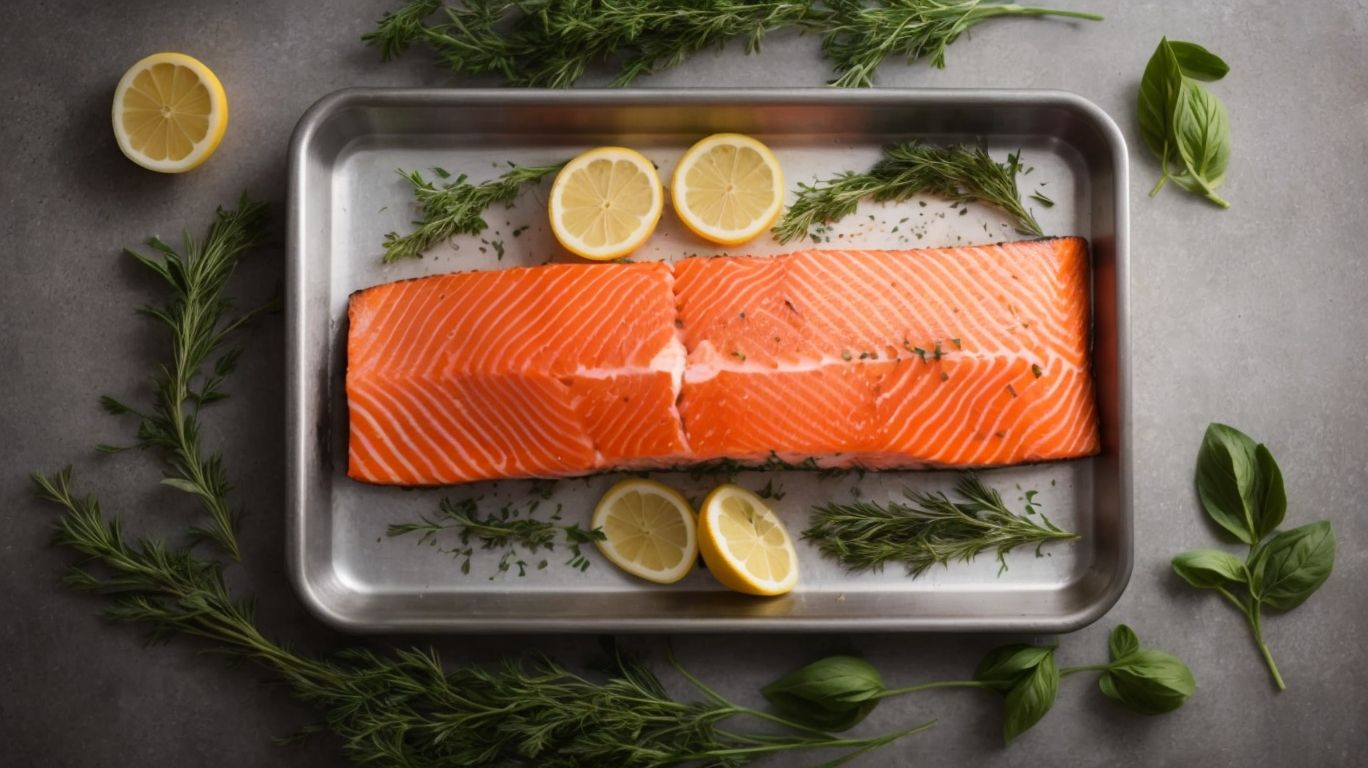How to Bake or Broil Salmon?
Salmon is a versatile and popular fish known for its rich flavor and numerous health benefits.
We will explore the different types of salmon, its nutritional benefits, and why baking or broiling is a healthy cooking method.
Learn how to prepare salmon for baking or broiling, including choosing the right type of salmon and seasoning it properly. Step-by-step guides for both baking and broiling salmon will be provided, along with tips and tricks for achieving perfectly cooked salmon every time.
Stay tuned for all the delicious details!
Key Takeaways:
What is Salmon?
Salmon is a popular fish known for its rich flavor and versatility in cooking.
“
Wild-caught salmon, prized for its robust taste and firm texture, is a favorite among seafood enthusiasts. This fish can be grilled, baked, or pan-seared to perfection, offering a melt-in-your-mouth experience. On the other hand, farm-raised salmon, while milder in flavor, boasts a buttery consistency that works well in various dishes. Whether you’re enjoying a simple smoked salmon appetizer or indulging in a luxurious salmon fillet, this fish always delivers a delightful culinary experience.
What are the Different Types of Salmon?
There are various types of salmon available, including Atlantic, Sockeye, and Coho, each with its unique flavor profile and characteristics.
Atlantic salmon, often considered the ‘classic’ salmon, boasts a rich, buttery flavor with tender flesh. On the other hand, Sockeye salmon, known for its vibrant red-orange hue, has a more robust taste that is slightly less fatty. Coho salmon, with its milder flavor and firmer texture, is popular for its versatility in cooking methods, such as grilling or baking.
Why is Salmon a Popular Fish?
Salmon enjoys popularity due to its delicious taste, health benefits, and versatility in culinary preparations.
One of the main reasons behind salmon’s widespread appeal is its exceptional nutritional value. Packed with high-quality protein, essential vitamins like B12 and D, minerals such as selenium, and omega-3 fatty acids, salmon is considered a superfood that promotes heart health, brain function, and overall well-being. Its rich, buttery flavor and delicate texture make it a favorite among seafood enthusiasts and even those who aren’t typically fond of fish. Salmon’s ease of cooking adds to its popularity, as it can be baked, grilled, poached, or even enjoyed raw in sushi and sashimi dishes.
Benefits of Baking or Broiling Salmon
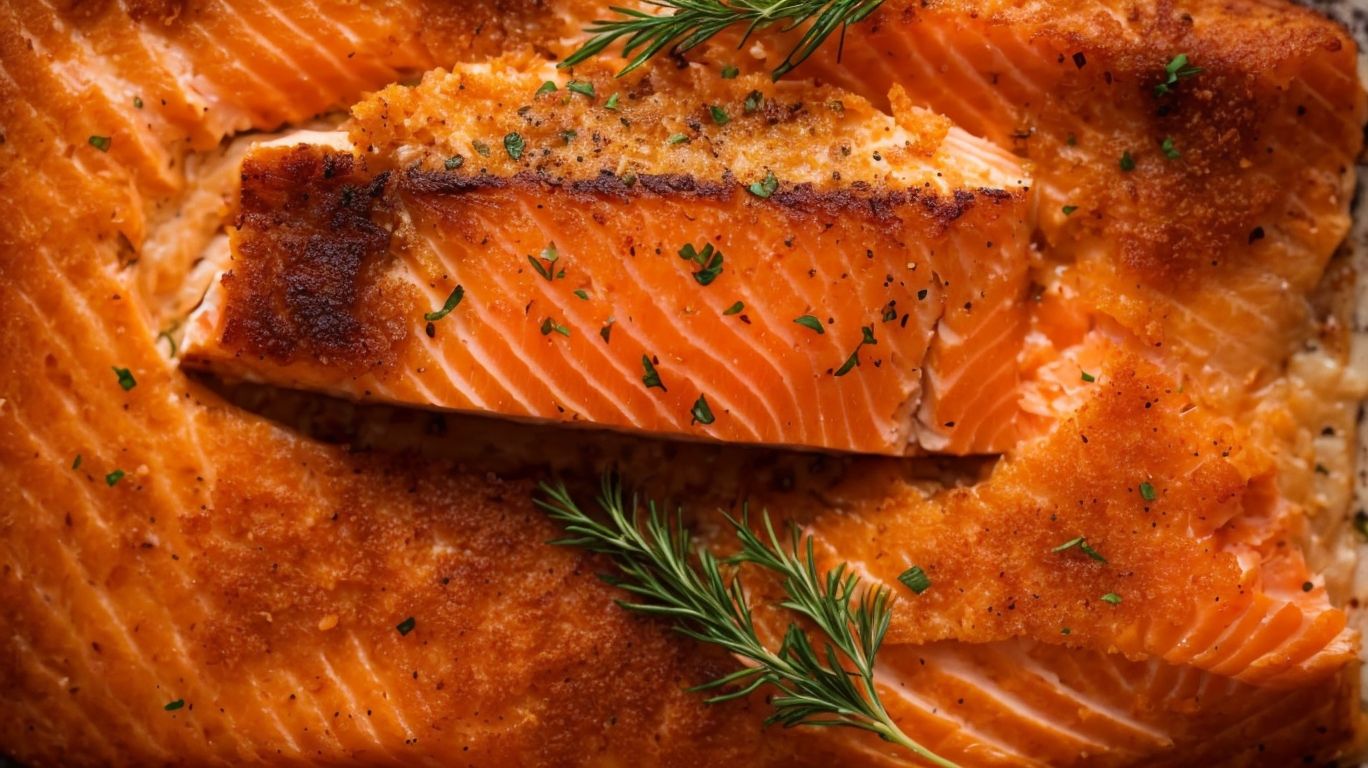
Credits: Poormet.Com – James Flores
Baking or broiling salmon offers a healthier cooking alternative that preserves the fish’s natural flavors and nutrients while avoiding excessive oil or fat.
What are the Nutritional Benefits of Salmon?
Salmon is a nutrient-rich fish packed with omega-3 fatty acids, protein, vitamins, and minerals essential for overall health and well-being.
Omega-3 fatty acids found in salmon play a crucial role in brain function and heart health, reducing inflammation and lowering the risk of chronic diseases. In addition, salmon is a high-quality protein source, aiding in muscle growth and repair. It also provides a range of essential nutrients, including vitamin D, vitamin B12, and selenium, which are beneficial for immune function, bone health, and metabolism.
Why is Baking or Broiling a Healthy Cooking Method for Salmon?
Baking or broiling salmon is considered a healthy cooking method as it requires minimal added fats and preserves the fish’s natural nutrients and flavors.
By using techniques like baking or broiling, you can reduce the need for excessive amounts of oil, making your meal not only lighter on the stomach but also on the waistline. This method locks in the essential Omega-3 fatty acids found abundantly in salmon, promoting heart health and cognitive function. The gentle cooking process helps the fish retain its vitamins and minerals, ensuring that each bite is packed with nutritional goodness.
Preparing Salmon for Baking or Broiling
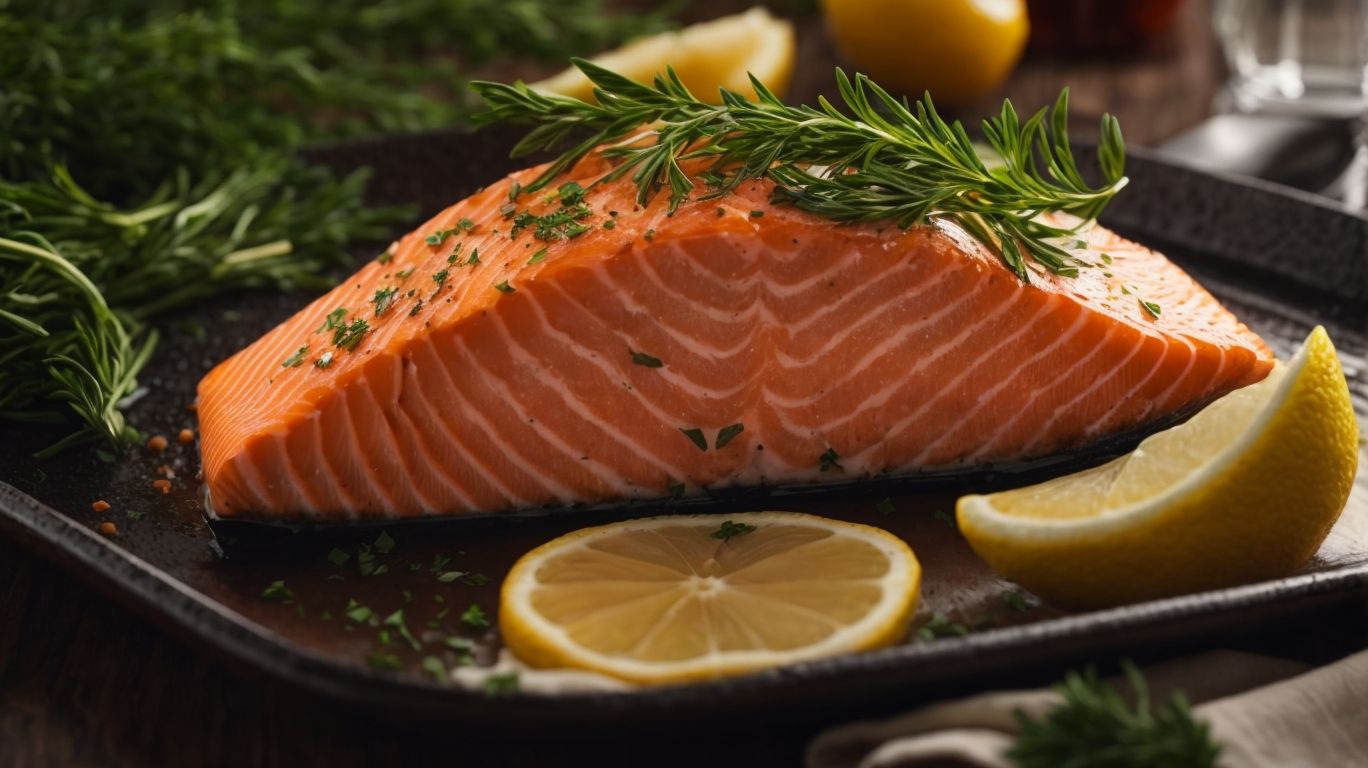
Credits: Poormet.Com – Anthony Green
Properly preparing salmon for baking or broiling ensures optimal taste and texture, enhancing the overall dining experience.
How to Choose the Right Salmon for Baking or Broiling?
Selecting the freshest salmon filets with vibrant color and no fishy odor is crucial for baking or broiling to ensure a delightful culinary experience.
When choosing salmon, look for fillets that are firm to the touch and have a shiny appearance. Avoid fish with discoloration or browning on the flesh, as this can indicate age or poor handling.
Opt for center-cut portions for even cooking, as they tend to be thicker and more uniform in shape. These cuts are ideal for methods like baking or broiling that require consistent thickness for proper cooking.
For environmentally conscious consumers, seek out salmon that is sustainably sourced to support responsible fishing practices and preserve marine ecosystems. Look for certifications like the Marine Stewardship Council (MSC) to ensure your seafood choice is eco-friendly.
How to Properly Thaw Frozen Salmon?
Thawing frozen salmon safely in the refrigerator or using a cold water bath is essential to maintain its texture and taste before baking or broiling.
When thawing salmon in the refrigerator, ensure it is wrapped in plastic to prevent cross-contamination with other foods and place it on a plate to catch any drips. Proper thawing prevents bacterial growth and preserves the fish quality. If you’re short on time, a cold water bath can expedite the process. Simply seal the salmon in a leak-proof bag and submerge it in cold water, changing the water every 30 minutes. This method is quicker but requires more attention to water temperature to ensure food safety.
How to Season Salmon for Baking or Broiling?
Seasoning salmon with a blend of herbs, spices, and citrus elements enhances its flavor profile and complements the natural richness of the fish.
When selecting herbs for salmon, consider incorporating fresh dill, which pairs beautifully with the fish’s delicate taste. Zesty lemon or tangy orange zest can brighten up the dish. To create a savory marinade, mix olive oil, garlic, and a touch of honey for a well-rounded flavor. For a hint of heat, adding a pinch of cayenne pepper or smoked paprika can elevate the dish. Whether baking or broiling, gently patting the seasonings onto the fish ensures an even distribution of flavors for a delicious outcome.
Baking Salmon
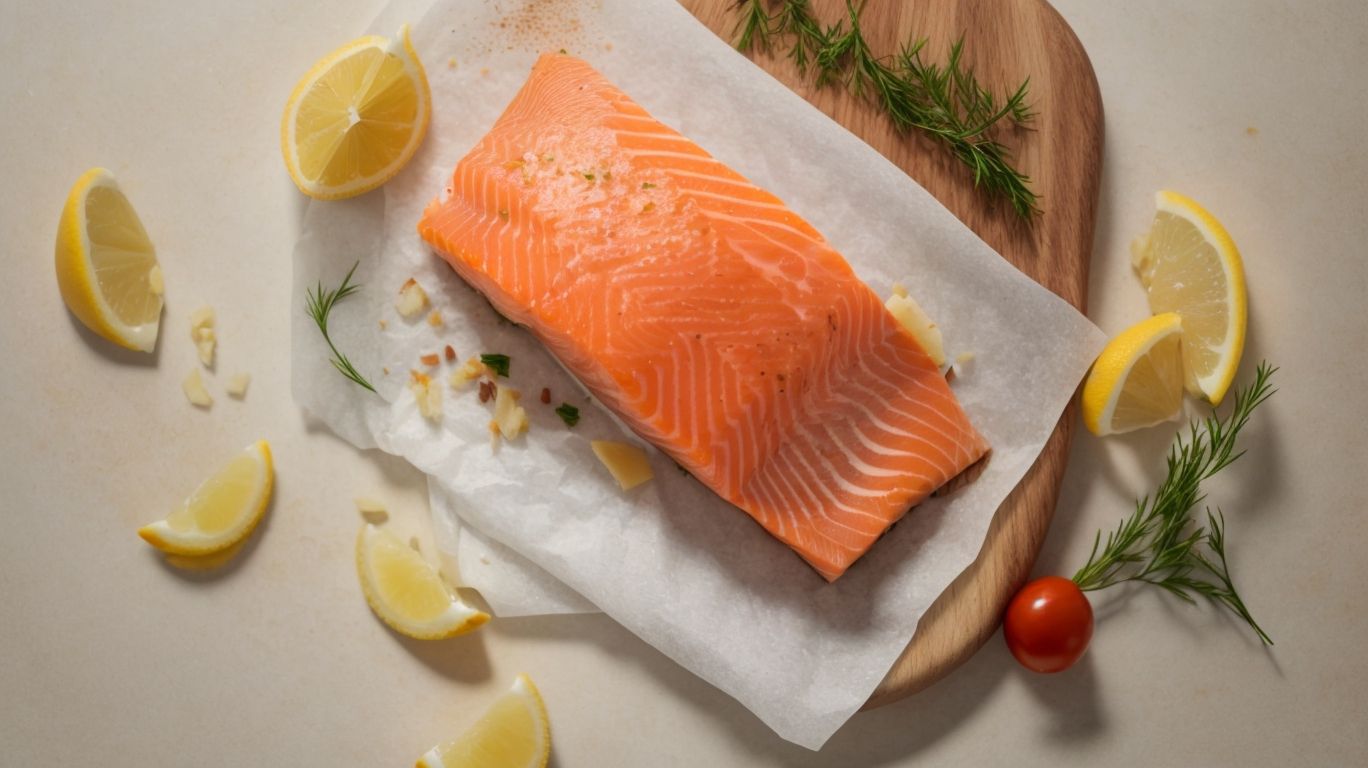
Credits: Poormet.Com – Jerry Walker
Baking salmon creates a moist and tender dish with a hint of delicate flavor, making it a popular cooking method for seafood enthusiasts.
Step-by-Step Guide to Baking Salmon
Follow this step-by-step guide to baking salmon to achieve a perfectly cooked dish every time, from seasoning to serving.
Start by selecting fresh salmon fillets at the market; ensure they are firm to the touch and have a vibrant color. Preheat your oven to the recommended temperature, usually around 375°F (190°C).
- Next, gently pat the salmon dry with paper towels before placing it on a lined baking sheet.
- Coat the fillets with a light drizzle of olive oil and sprinkle salt and pepper generously for a simple yet delicious seasoning. For added flavor, consider adding minced garlic, lemon slices, or fresh herbs like dill or parsley.
- When the oven is ready, carefully place the baking sheet in the center rack and let the salmon bake for around 12-15 minutes, or until the fish easily flakes with a fork.
How to Know When Salmon is Fully Cooked?
Determining the doneness of salmon involves observing its color, texture, and internal temperature to ensure a safe and enjoyable dining experience.
When checking for color changes in cooked salmon, look for the flesh to transition from translucent to opaque, indicating that it is done. The texture plays a crucial role too; perfectly cooked salmon will be tender, yet it should easily flake with a fork. Ensure that the fish is firm to the touch but still retains some moisture for optimal juiciness. These visual and tactile cues will help you achieve the ideal level of doneness while cooking salmon.
Broiling Salmon
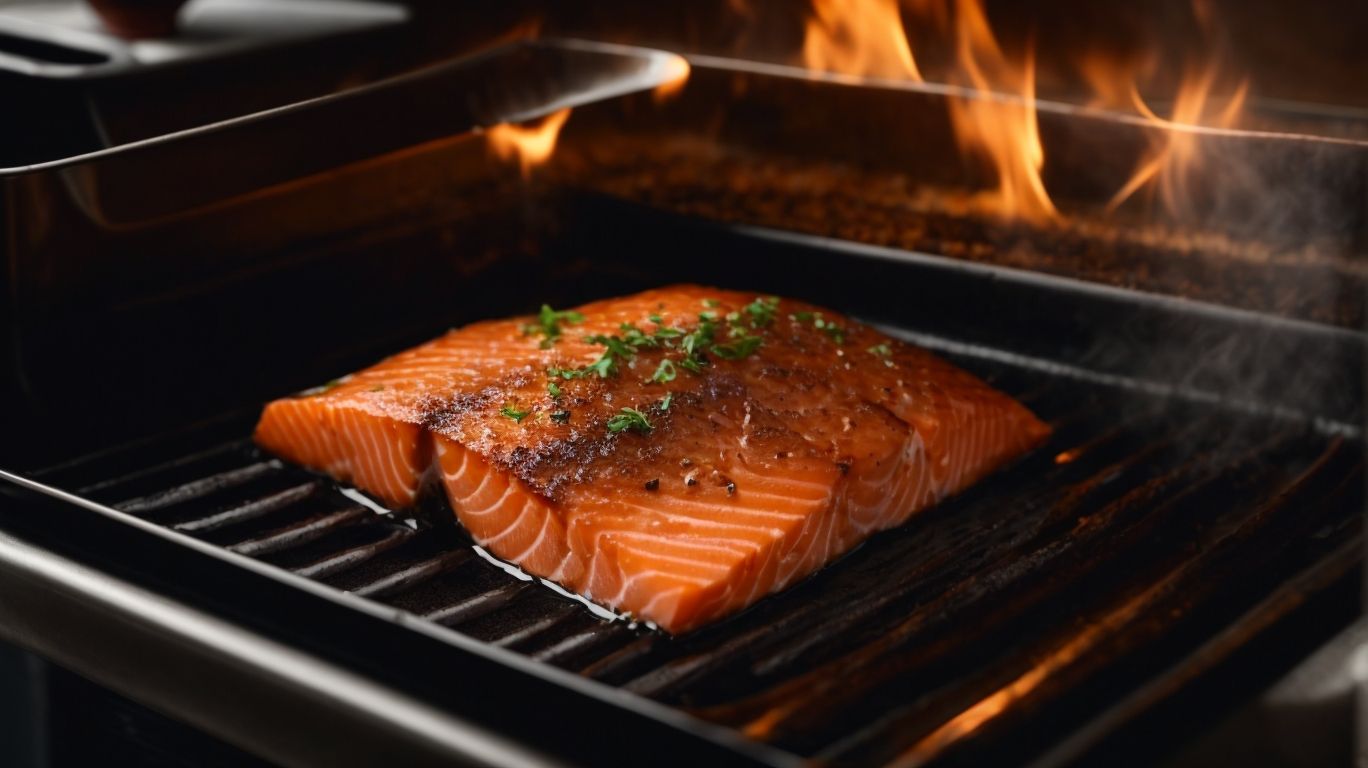
Credits: Poormet.Com – Willie Miller
Broiling salmon under high heat yields a flavorful crust and moist interior, offering a quick and convenient cooking method for seafood aficionados.
Step-by-Step Guide to Broiling Salmon
Master the art of broiling salmon with this comprehensive guide, detailing the preparation, broiling process, and serving suggestions for a delightful meal.
Before beginning the broiling process, ensure your salmon is fresh, cleaned, and patted dry with paper towels. Season it generously with salt, freshly ground black pepper, and a touch of olive oil for flavor. Preheat your broiler on high and position the oven rack about 6 inches from the heat source to allow for optimal cooking. Place the seasoned salmon on a foil-lined baking sheet for easy cleanup.
When broiling, keep a close eye on the fish to prevent overcooking. The rule of thumb is to broil salmon for about 4-6 minutes per half-inch of thickness, turning once halfway through the cooking process for even browning.
For added flavor, brush the salmon with a mixture of honey, soy sauce, and minced garlic before broiling to create a delicious glaze. Serve the perfectly broiled salmon with a squeeze of lemon juice, fresh herbs, and a side of steamed vegetables for a well-rounded and tasty meal.
How to Know When Salmon is Fully Cooked?
Ensure salmon is perfectly cooked by assessing its internal temperature, color changes, and flakiness to achieve a delectable and safe dining experience.
When broiling salmon, it’s crucial to pay attention to the texture and appearance to determine its doneness. Fully cooked salmon should have a firm texture but still be moist and tender. The color of the fish should turn from translucent to opaque and have a vibrant pinkish hue. To achieve this, broil the salmon for about 4-6 minutes per ½ inch thickness, ensuring it reaches an internal temperature of 145°F (63°C).
For added flavor, consider marinating the salmon before broiling or brushing it with a mixture of olive oil, lemon juice, and herbs. Remember to always handle raw salmon carefully to prevent cross-contamination, and wash your hands thoroughly after touching it.
Tips and Tricks for Perfectly Baked or Broiled Salmon
Enhance your baked or broiled salmon dishes with expert tips, from marinating techniques to topping suggestions, ensuring a flavorful and succulent seafood experience.
How to Prevent Salmon from Drying Out?
Safeguard your salmon from drying out during baking or broiling by employing methods like sealing in moisture, monitoring cooking times, and utilizing flavorful marinades.
One effective way to seal in moisture is by creating a foil packet for your salmon, ensuring that the fish steams in its juices, keeping it succulent and tender throughout the cooking process. You can control the cooking temperature to prevent overcooking, which can lead to dryness. Consider using a lower temperature and slightly longer cooking time to help retain the natural juices of the salmon.
What are Some Flavorful Toppings for Baked or Broiled Salmon?
Elevate the taste of your baked or broiled salmon with a variety of flavorful toppings, such as citrus herb butter, tangy salsa, or crunchy almond crust.
For a refreshing twist, try topping your salmon with a zesty mango salsa bursting with tropical flavors. If you prefer a rich and savory touch, consider a decadent lemon dill cream sauce that complements the salmon perfectly. For those who enjoy a hint of sweetness, a balsamic glaze drizzled over the fish adds depth and complexity to the dish. Alternatively, opt for a unique crabmeat and herb stuffing for a luxurious combination of textures and flavors.
Conclusion
Mastering the art of baking or broiling salmon opens up a world of culinary possibilities, offering a healthy, flavorful, and versatile dish for seafood enthusiasts.
Regarding baking salmon, the gentle heat of the oven helps the fish cook evenly, preserving its natural juices and enhancing its delicate flavors. This method is perfect for creating moist and tender salmon fillets with a mild smoky taste.
On the other hand, broiling salmon involves exposing the fish to direct, high heat, resulting in a caramelized exterior and a slightly crispy texture. Both techniques provide unique taste profiles, allowing you to experiment with various seasonings such as garlic, herbs, lemon, or honey glaze for a flavorful twist.
Final Thoughts and Recommendations for Baking or Broiling Salmon
As you embark on your culinary journey with salmon, remember to experiment with different seasonings, cooking methods, and accompaniments to create delightful meals that cater to your taste preferences.
Discover the versatile world of salmon and its ability to adapt to various flavors. Incorporating ingredients such as lemon, dill, garlic, and honey can bring out the rich flavors of this nutritious fish.
Whether you choose to bake or broil your salmon, ensure that it is cooked to perfection by using a cooking thermometer to check for an internal temperature of 145°F. This guarantees a moist and tender texture that will tantalize your taste buds.
Try experimenting with different cooking times and temperatures to find the ideal balance that suits your palate. Remember, the key to a delicious salmon dish lies in the details of preparation and seasoning.
Frequently Asked Questions
How to Bake or Broil Salmon?
What is the best way to cook salmon?
Salmon can be baked or broiled for equally delicious results. It just depends on your preference and the texture you want to achieve.
How to Bake or Broil Salmon?
What temperature should I set my oven to when baking salmon?
The ideal temperature for baking salmon is 375°F. This ensures that the salmon cooks evenly without drying out.
How to Bake or Broil Salmon?
Can I use frozen salmon for baking or broiling?
Yes, you can use frozen salmon for baking or broiling. Just make sure to properly thaw it before cooking to ensure even cooking.
How to Bake or Broil Salmon?
How do I know when the salmon is fully cooked?
The salmon is fully cooked when it flakes easily with a fork. The internal temperature should also reach 145°F.
How to Bake or Broil Salmon?
Do I need to marinate the salmon before baking or broiling?
It is not necessary to marinate the salmon, but it can add extra flavor. If you do choose to marinate, make sure to pat the salmon dry before cooking.
How to Bake or Broil Salmon?
Do I need to use oil when baking or broiling salmon?
It is not necessary to use oil, but it can help prevent the salmon from sticking to the pan. If you prefer a healthier option, you can use parchment paper or a non-stick cooking spray.

